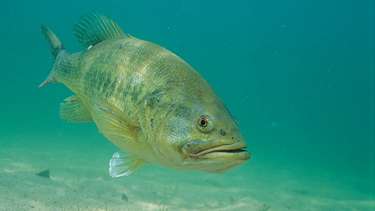
In this series, we'll explore the senses of bass (Micropterus sp.) and how they relate to their environment. Although not quite capable of cognitive thought like you or I, they didn't reach the top of the freshwater food chain by being slackers.
Their senses have been refined over millennia, allowing them to become one of the most sought after, wily game fish in the freshwater environment.
To truly appreciate this exceptional predator, you need to know how they see, hear, feel, smell and taste. Doing so will result in a more frequent, up-close and personal look at North America's most prominent fish on the end of your line.
The eye of the beholder
Sight is probably the most important sense of the bass genus. I say "probably" because most of the research on bass to date has focused on population management, life history, predator/prey interactions, reproductive biology, etc., rather than specific physiological characteristics. However, we do know enough about similar species — and bass in general — to draw some conclusions.
To understand the commitment to sight in the bass species, one needs look no further than the fish's brain. The ocular lobe of the bass is huge, relatively speaking. This means that the fish invests much of its neurological resources in its ability to see.
Anecdotal evidence seems to confirm what scientists see in a lab. In perpetually turbid or dingy waters, bass struggle to grow to trophy size, even if the waters are fairly productive. Why? They can't see well enough to find adequate prey. That's nothing new to the average bass angler. But, what do bass really see? To understand that, we must look at the eye structure itself.
They have bulbous, protruding eyes positioned on both sides of the head that enable them to see a much wider field of view than you or I can see. Basically, their only blind spots are directly below and behind them.
However, much of that sight is monocular, rather than binocular. What's the significance? In order to focus on an object and truly get a good view, both eyes have to see it simultaneously. That means the bass has to be facing the object to discern the true shape and distance, and even then, it has to be pretty close. They may be able to detect motion on one side or the other, but they don't truly understand what they are seeing until they position themselves so that both eyes are peering in the same direction.
Now for the most popular question we biologists get about bass vision, do bass see color? Without a doubt, yes! Not unlike humans, bass have cellular structures in the retina called cones and rods. Rods allow an animal to see black, gray and white in low-light conditions, while cones allow an animal to see color. The exact kind and quantity of cones in bass is uncertain, but the plentiful existence of cones, along with related research, indicates that color selection can be important, depending on the conditions.
Color is a product of light. Light is both absorbed and refracted by water, and the shorter the wavelength, the deeper the color can penetrate. In clear water, the blue end of the spectrum is visible at the deepest depths, while the red end is absorbed more quickly.
However, the clarity of the water also plays a role. If there is a strong algal bloom, or the water is muddy from a recent rain, light behaves differently. In these conditions, colors that contrast with the surrounding water will be noticed more quickly. At night, bass rely on their retinal rods, just as we do, to see shadows and movement. During new moons, there isn't a lot of ambient light in the water, and it dissipates quickly with depth. In these conditions, darker lures have more contrast and can be seen better. On bright, moonlit nights where more light penetrates, more lure colors will be visible to a bass.
Bass can see color. Paying attention to color can make the difference between a curious follow and a definitive attempt to eat your lure.
Originally published January 2011




